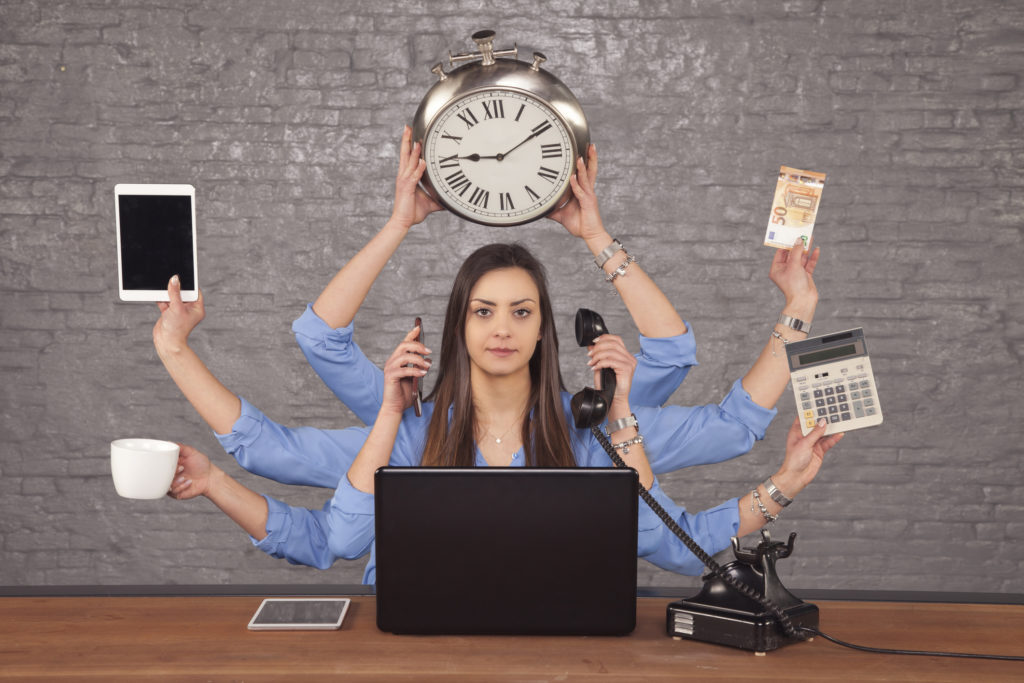By Melody Huang, OD

Nov. 20, 2019
Multitasking is a challenge many would like to eliminate from their lives, but there could be a bright side to it–if you learn to multitask as efficiently as possible.
Here is how I have learned to navigate a multitasking-heavy professional life, and the benefits I’ve found to doing it well.
When Do You Multitask in Your Work Day?
As optometrists, many of us have become skilled multi-taskers. I can definitely say that working at busy optometry practices as a freelance OD has tested my multitasking skills. We’ve all encountered similar scenarios where we multitask:
● Filling out the patient’s chart while doing a refraction.
● Explaining diabetic retinopathy to your patient while writing a report for their primary-care physician.
● Answering the patient’s questions while trying to calculate their reading prescription.
These tasks may not sound that difficult, but when you’re doing them multiple times a day, your brain can get frazzled. I’ve caught typos after writing a referral report, or realized that I forgot to write a finding in the patient’s chart.
I find that sometimes, you just need to take a moment. Even if you have two patients waiting on you, and you’re running 40 minutes behind, it’s OK to tell your patient, “Please give me a minute while I finish up.” I realized that if I tried to be too efficient with my time, I might end up getting overwhelmed. It’s in your best interest, and also your patient’s, to take that extra minute for yourself.
Could Multitasking Be Good for You?
Multitasking can be a useful skill to develop. In fact, a study showed that those who frequently multi-tasked with different types of media or technology were better at integrating information from various senses (vision and hearing, in this case). This is good news if it means we can be better at listening to patients while charting at the same time!
Help Multitasking
● Daily planners are inexpensive and help you visualize all of your tasks. I write down everything I want to accomplish in a given day, in order from most to least important. Next to each task I write how much time I want to spend on it. I like the satisfaction of crossing each task off the list when I’m done.
● Google Calendar is a great alternative if you don’t want to write. It’s great because you can color-code different calendars for work tasks, personal tasks, etc.
● Trello is excellent if you want to go the extra step and be super-organized. You can use this free program to create detailed boards and to-do lists. Trello works for everything from planning a big vacation to finishing a new project at work. You can even collaborate and share with family members, friends or co-workers.
● Toggl is a time-tracking app that will help you monitor how much time you spend on each task. The basic version is free, but there are many other great features with the paid version
Developing these skills has helped me handle stressful work situations better. During a busy workday, multitasking keeps my schedule from getting too backed up because I’m more efficient. This also means I don’t need to stay late after work to finish up charts. I definitely feel less stressed knowing I don’t have a huge pile of work at the end of the day.
Organize First, Then Multitask
The key is to organize first before starting tasks. Without organization, multitasking can be chaotic and overwhelming. I like to start the day by making a list of what I want to accomplish, with the most important tasks first. From there, I write down how long I think it will take me to finish each task.
I also like to keep track of how much time I spend on a given task. If I dedicate too little time, by the time I get comfortable with my task, it’s already time to switch. Because it can take time for your brain to “switch gears” between tasks, give yourself a little buffer. If I dedicate too much time, my brain might get tired of the same task and I’ll hit a wall. That’s when I know it’s time to do something else.
The More You Do It, the Better at Multitasking You Become
When I was in optometry school, we had an electronic medical record system at our school clinic. As fourth-year interns, we were assigned second-year students to be our medical scribes.
Other Articles to Explore
Between trying to sound confident while talking to patients, figuring out the right prescription for their glasses, making sure you don’t miss any ocular health findings, and hoping your clinic supervisor will give you a pass, there’s a lot to manage as an optometry intern. Not having to worry about typing the patient’s chart at the same time was a relief. Now, it feels like second nature to chart and refract at the same time.
Looking back, I can say that effective multitasking is a mark of a seasoned practitioner. With the addition of technology-driven tools in the office like autophoropters, tablets and practice management software, we are equipped to become better multi-taskers than ever before.
Multitasking Is One Thing; Unrealistic Workload Is Another
I’ve worked at practices with two or more doctors working side by side at any given time. We typically alternated seeing the next patient, so that we would each see about the same number of patients by the end of the day. This system worked well when all of us saw patients at about the same pace.
Occasionally, I would work with other optometrists who operated at a much slower pace. As a result, the staff would pile my schedule with more patients to make up for these other doctors’ lower productivity. Of course, I was willing to help a colleague out. But after repeated occurrences, I started to feel like my efficiency was only creating more work, and I was feeling burnt out. In the end, I spoke to the office manager to let her know how I felt. She spoke to the other optometrist and tried to make sure the workload was distributed more equally from then on.
This experience showed me that even though your multitasking abilities and efficiency may be rewarded in the workplace, you may also be penalized for them. The lesson here is that you must always speak up for yourself at work if something doesn’t feel right. You are your best advocate, not anyone else.
Multitasking has its place at work and in our personal lives. I like to balance this out by knowing that sometimes, it’s OK not to operate at peak efficiency. Once in a while, we all need to slow down to keep from burning out. Take that coffee break, spend five minutes stretching in your office, or step outside for a minute to get some sun!
 Melody Huang, OD, is a freelance optometrist and writer practicing in Los Angeles, Calif. To contact her: mhuang.opt@gmail.com
Melody Huang, OD, is a freelance optometrist and writer practicing in Los Angeles, Calif. To contact her: mhuang.opt@gmail.com



























